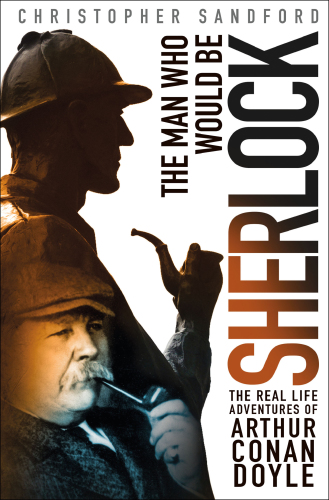
The Man Who Would Be Sherlock
The Real-Life Adventures of Arthur Conan Doyle
- اطلاعات
- نقد و بررسی
- دیدگاه کاربران
نقد و بررسی

July 16, 2018
The subject of how the creator of Sherlock Holmes emulated his famous detective in real life is not a new one, and this sloppy account by biographer Sandford (Union Jack) of two of Conan Doyle’s most famous inquiries suffers by comparison with the better books available. Instead of adding new information and insight, Sandford relates an unconvincing revisionist history of how the mystery author helped exonerate two men, accused murderer Oscar Slater and alleged poison-pen writer and animal-mutilator George Edalji. Lack of reliable sourcing is a problem; he presents an unverified anecdote that Conan Doyle identified Jack the Ripper as an associate of the royal family as a factual instance of the writer’s crime-solving prowess. Sandford is similarly speculative when he suggests that Slater and Edalji were actually complicit in the crimes for which they were accused. Mystery fans interested in the Sherlock author’s track record as a champion for the unjustly accused will prefer the recent Conan Doyle for the Defense to this unevenly written and overly speculative account.

October 1, 2018
A tale of two detectives.In this dry foray into the ever fascinating life of Arthur Conan Doyle (1859-1930), celebrity biographer Sandford (Union Jack: JFK's Special Relationship with Great Britain, 2017, etc.) seeks to "show the ways in which Doyle himself consistently applied both the intellect and innate sense of justice (if not always the mercurial powers of observation) of his immortal creation." It may come as something of a surprise to Sherlock Holmes' legions of fans that his creator was often personally involved in real-life criminal cases. Doyle, a successful author who also maintained a medical practice, "consistently came to the defense of the persecuted or oppressed"--and "if the aggrieved party happened to be a lady, so much the better." Sandford examines a number of cases Doyle took a personal interest in, including the famous disappearance of Agatha Christie in 1926 and his defense of the later-debunked photograph of the Cottingley fairies, which Sandford calls Doyle's "most notorious literary act," but he largely focuses on two scandalous crimes: the 1906 case of the young Anglo-Indian lawyer George Edalji--the subject of Julian Barnes' outstanding novel, Arthur & George--who was accused of writing a series of anonymous, inflammatory letters to his father, the Rev. Edalji, as well as mutilating cattle. He was found guilty and imprisoned. Sandford meticulously describes Doyle's involvement in the case. He met with George and became an ardent supporter of his innocence in the pursuit of justice. Doyle insisted that his persecution "owed more to racial prejudice and to rank blundering on the part of the authorities." Doyle also became an active participant in the case of Oscar Slater, who supposedly robbed and murdered an elderly Glasgow woman. Doyle "spoke persuasively about the shortcomings and contradictions of Slater's prosecution." Sandford's discussion of Doyle, Harry Houdini, and spiritualism is a rehash of his earlier book, Masters of Mystery (2011).Workmanlike but rather prosaic.
COPYRIGHT(2018) Kirkus Reviews, ALL RIGHTS RESERVED.

October 1, 2018
Arthur Conan Doyle's most famous creation, Sherlock Holmes, intrigues us because he seems to "embody the past and belong to the present," writes Sandford (Houdini and Conan Doyle). Considering the criminal cases and contemporary causes that engaged Holmes's author throughout his prolific life (1859-1930), many of which crept into his fiction, one can believe the same of Conan Doyle. Never one to flinch from an intellectual challenge or a cause célèbre, Conan Doyle frequently brought his unique mix of cold logic, rational belief, and innate chivalry to the underdog's aid, especially when he believed that a serious miscarriage of justice had occurred. This book pays particular attention to two famous examples. Conan Doyle's championing of George Edalji, accused of maliciously wounding livestock, and Oscar Slater, accused of murdering a Glaswegian woman he'd never met, led to the reconsideration of their cases and eventual freedom for both. In stark contrast, the creator of the world's greatest detective remained a proponent of spiritualism to his death, despite many questioning his sanity. VERDICT Sandford's accomplished, well-crafted work brings Conan Doyle into sharp relief as a man of scrupulous fairness and great integrity.--Penelope J.M. Klein, Fayetteville, NY
Copyright 2018 Library Journal, LLC Used with permission.

October 15, 2018
Arthur Conan Doyle always sought to make it clear that his creation, the great detective Sherlock Holmes, was not based on him. Then he went on to solve puzzling crimes with Holmesian displays of close observation and deduction. He tracked a missing person by studying railroad timetables, and he untangled the false convictions of George Edalji for animal mutilation and pimp-and-panderer Oscar Slater for murder. In this impressively researched account, Sandford takes a fresh look at the last two cases, noting that ongoing research suggests Edalji was not an angel, and questions of Slater's total innocence are "another matter." He gives the last quarter of the book to a study of Doyle's fascination with spiritualism, attempting to show a kind of unity in the way Holmes combined "the qualities of a rational thinker" with an "interest in the intangibles." Still, many readers will find it sad to hear Doyle burbling on about fairies as "beautiful, luminous creatures" after beholding a tricked-up photo. His erstwhile friend Harry Houdini spoke of Doyle as "a sadly deluded old man," and Sandford drives that point home forcefully.(Reprinted with permission of Booklist, copyright 2018, American Library Association.)




دیدگاه کاربران